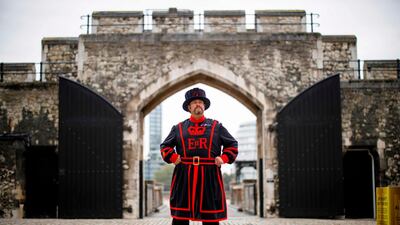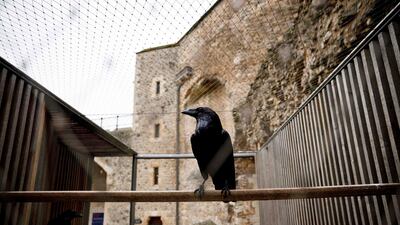Chris Skaife has one of the most important jobs in Britain. As Yeoman Warder Ravenmaster at the Tower of London, he is responsible for the country's most famous birds – the eight ravens who inhabit Britain's most popular tourist attraction.
Mr Skaife had his work cut out, however, when the country was plunged into lockdown in March: the Tower was closed, the tourists stopped visiting and in their absence the birds were left almost alone in the cavernous fortress.
That’s entertainment
The Ravenmaster -- who is in his 50s and a retired staff sergeant and former drum major in the Princess of Wales's Royal Regiment -- was furloughed, but still he came to look after his majestic feathered charges, rotating feeding and caring duties with his three assistants.
Between them, they faced the unprecedented challenge of how to entertain the celebrated ravens, who suddenly found themselves with no one to play with -- or rob food from.
"During that period of time, the ravens didn't actually see anybody," Mr Skaife told AFP.
"There were slight changes that I noticed. For instance, I had to keep them occupied without the public being there [and] there were less things for them to do.
"So I gave them enrichment toys that would help them enjoy their day."
With no people around, he put balloons, ladders and even mirrors in their cages to keep them entertained, and hid food treats around the Tower grounds for them to find.
Slim pickings
With no tourists to offer them food, though, the ravens need extra sustenance, too, on top of the hidden titbits. Breakfast time involves Mr Skaife, in the distinctive black and red uniform of the "Beefeaters", distributing a meal of chicks and mice, which the ravens -- Merlina, Poppy, Erin, Jubilee, Rocky, Harris, Gripp and George -- cheerfully devour.
The Ravenmaster's favourite is Merlina, he said with a smile.
She has become an internet hit from his frequent posts and videos of her on his Instagram and Twitter accounts, which have more than 120,000 followers.
Once feeding time is over, he opens the cages on the south lawn to allow them to stretch their wings.
Keeping the birds within the confines of the 1,000-year-old Tower has also been a priority. According to legend, if all the ravens were to leave the Tower, the kingdom would collapse and the country be plunged into chaos.
They are free to roam the grounds but to prevent them from flying too far, their wings are trimmed back slightly.
During the three-month national lockdown, Mr Skaife said the ravens were given more freedom to explore other parts of the Tower.
But to be doubly sure they didn't fly off completely, their wings were clipped back further.
Caged confinement
The birds are now kept in their cages more often to make sure they eat enough, as there are slim pickings from the Tower's rubbish bins because of the reduced footfall.
"I don't particularly like doing it," said Mr Skaife.
He says the ravens may be kept in cages but the Tower is their real home.
"So, I would never want to keep a raven in an enclosure."
The Tower reopened its doors on July 10 but the pandemic has had a devastating effect on visitor numbers.
Some 60,000 people visited every week in October 2019 but it is now only 6,000, according to Historic Royal Palaces, which manages the site.
However, as life returns to a semblance of normality, the ravens are re-adapting to their old routine -- and getting used to seeing more humans again.
Mr Skaife has looked after the ravens for the past 14 years, tending to their needs out of clear affection but also out of a sense of historic and patriotic duty.
"Of course, we don't want the legend to come true," he said.








